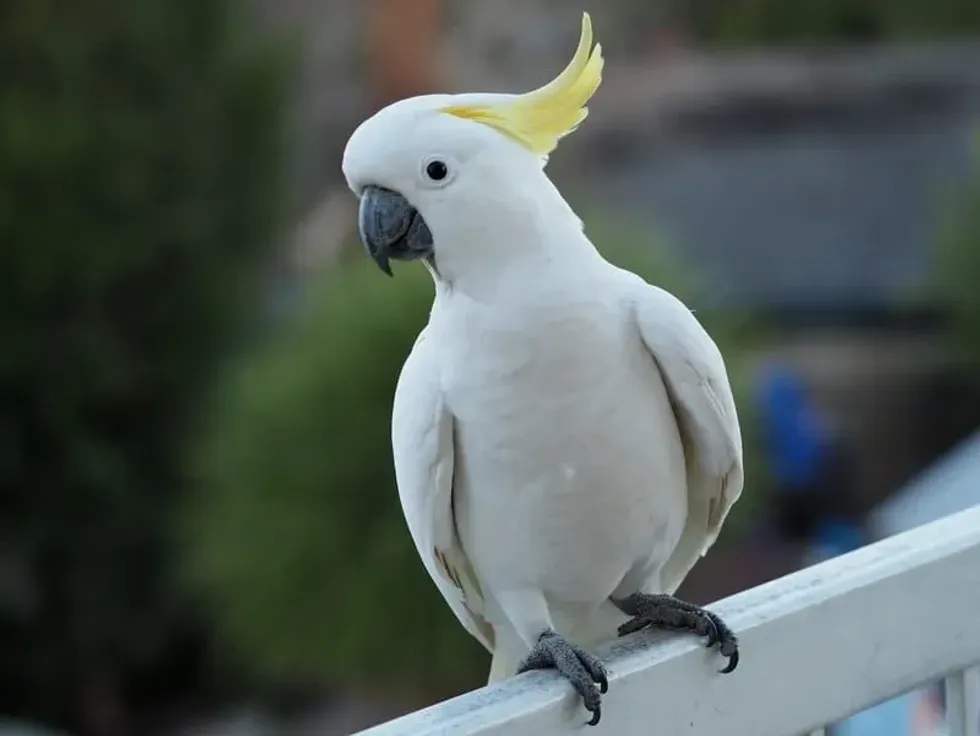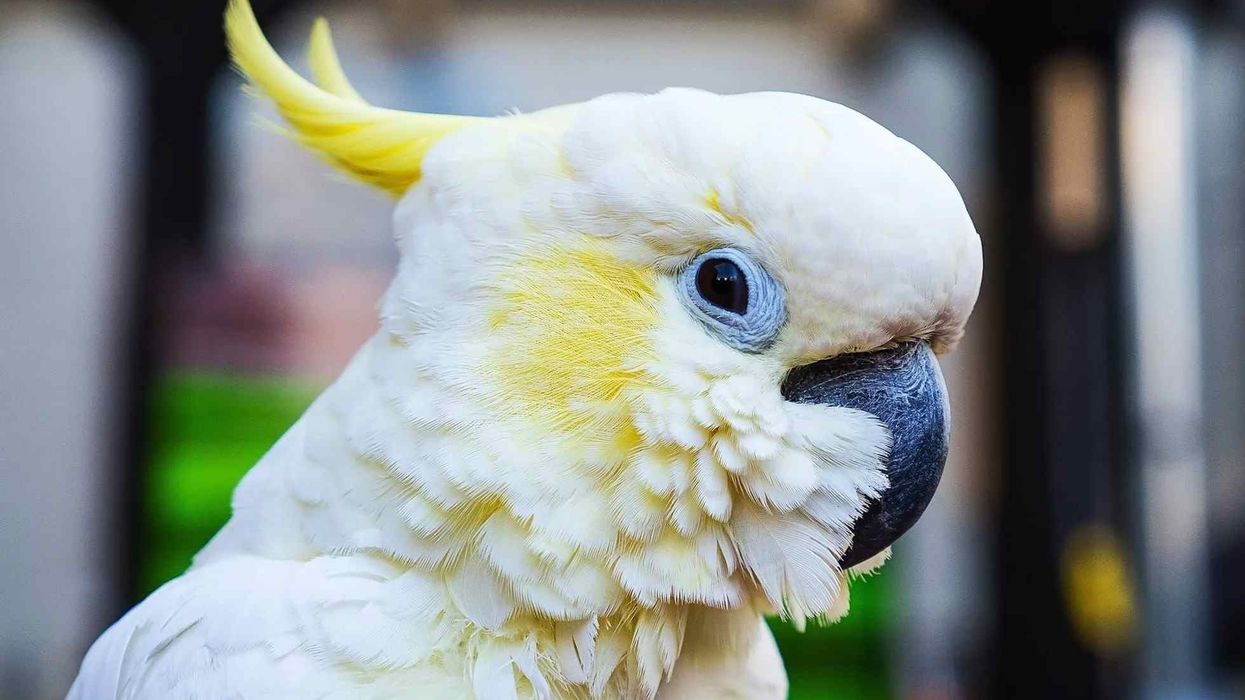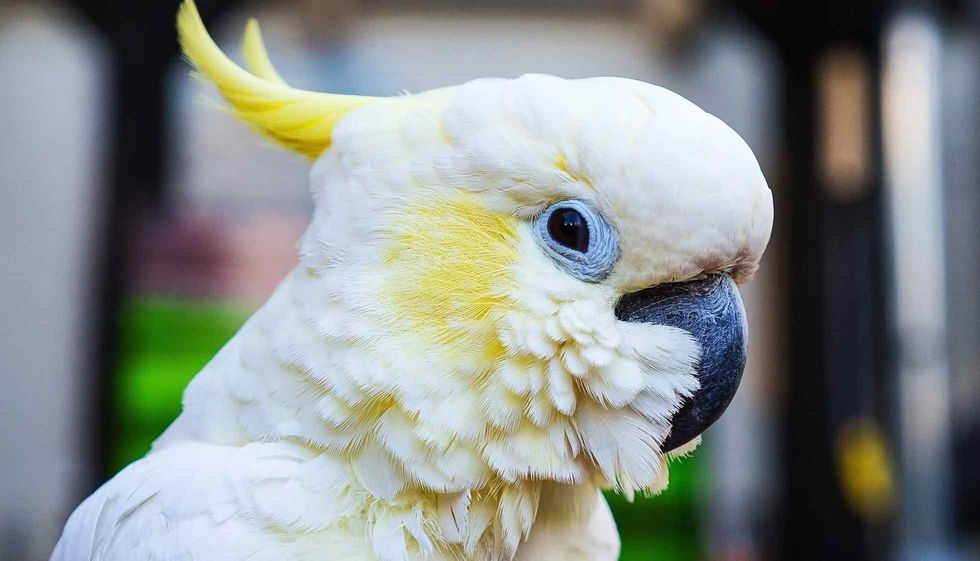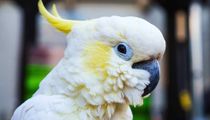Fun Cockatoo Facts For Kids

Cockatoos, also called ‘velcro birds’ are highly sociable and love to be near people. They are a loving, but certainly demanding bird species.
They have certain features that make them stand out from other species of parrot including their dramatic crest feathers in varying shades of gray, white, black, and pink. Their size can be anywhere between medium to large.
There are 21 cockatoo species belonging to the Cacatuide family. These cockatoo species, such as the red-tailed black cockatoo, the sulfur-crested cockatoo, the yellow-crested cockatoo, palm cockatoos, the white cockatoo, and the black cockatoo, have native ranges in Australasia, Australia, New Guinea, Indonesia, and the Solomon Islands.
The crested cockatoo (Cacatua galerita) species are emotional and intelligent animals that can be good pets. They are capable of complete silliness and can be quite attention-seeking.
This bird might also speak a few words to you! Some species of cockatoos are prone to pulling out or picking at their feathers when they are not provided with enough mental stimulation, and some other conditions that can affect crested cockatoos are Psittacine Beak and Feather Disease (PBFD), obesity, or fatty liver disease.
Read on to learn more about these birds, and for more, check out our guides to birds of paradise and the barn owl too!
Cockatoo Interesting Facts
What type of animal is a cockatoo?
The cockatoo species is a type of parrot from the Cacatuide family. Its name comes from ‘kaketoe’, a Dutch word derived from 'Kakatua' where ‘kaka’ means 'parrot'.
Together with New Zealand parrots, cockatoos are one of the major species of birds making up the Psittaciformes order of parrots.
Currently, there are 21 living cockatoos species spread across seven genera, including the red-tailed black cockatoo, the sulfur-crested cockatoo, the yellow-crested cockatoo, palm cockatoos, the white cockatoo, and the black cockatoo. Scientists have also found evidence of a few extinct cockatoos through fossil records.
What class of animal does a cockatoo belong to?
The cockatoo species is a parrot of medium to large size. These animals belong to the Aves class.
How many cockatoos are there in the world?
Whilst the total number of cockatoos in the world is unknown, we do know that there are 21 difference species of cockatoos.
Where does a cockatoo live?
Cockatoos mainly live in New Guinea, Australia, the Philippines, Indonesia, and the Solomon Islands in utilize rainforest, dry forests, open country, mangrove, eucalyptus grove, and scrublands habitats.
What is a cockatoo's habitat?
They can inhibit forests, mountains, rainforests, shrublands, dry forests, mangroves, and more. Some species live in crop fields, farmland, and even cities or parks.
Who do cockatoos live with?
Also known as velcro birds, cockatoos like to live around humans as pets. In the wild, they live in enormous flocks.
How long does a cockatoo live?
The typical cockatoo lifespan is somewhere between 40 and 70 years. However, there have been reports of these birds living more than 100 years in captivity.
How do they reproduce?
Fater female and male cockatoos mate, the female lays eggs and both parents incubate them. About 30 days, the eggs hatch.
What is their conservation status?
According to the International Union for Conservation of Nature, there are seven species of cockatoo that are considered Vulnerable or worse. One species is Near Threatened. Two species, the yellow-crested and the red-vented cockatoo, are Critically Endangered.
Cockatoo Fun Facts
What do cockatoos look like?
The cockatoo species is a parrot of medium to large size with small rounded eyes, a muscular tongue, an elaborate head crest, and a big curved beak. It can lower and raise its head crest at will to signal its mood to others.
They also have zygodactyls on their feet, an arrangement that means that two of their toes are pointed backward and two are pointed forward. It's thanks to this that they can climb trees with precision and grip branches tightly.
They can also grip their food with one foot and climb a tree with the other. When compared to parrots, most of the cockatoos have less coloration.
They are arrayed in simple white and black colors and lack the colorful textures usually found in parrots. However, there are a few species of cockatoos with bright, elaborate colors such as reds, greens, blues, and yellows.

How cute are they?
Cockatoos are less colorful than parrots but they make up for it by being one of the cutest birds, they are popular pets.
How do they communicate?
In the wild, cockatoos need to communicate important information and their feelings to their family. They use their body language and loud screeching noises to do this. As pets, cockatoos learn to adapt their sound range according to their surroundings.
How big is a cockatoo?
Cockatoos are stocky birds of medium to large size. Their length can range from 11.8-23.6 in (30-60 cm).
How fast can a cockatoo fly?
Cockatoos have strong claws, short legs, and a waddling gait. They often use their strong bill as a third limb for climbing through branches and their broad wings help them reach rapid flight speeds of up to 43.5 mph (70 kmph).
How much does a cockatoo weigh?
The average weight of a cockatoo is between 2.82-3.53 oz (80-100 g).
What are their male and female names of the species?
There are no specific names for male and female cockatoos (both as pets and in the wild).
What would you call a baby cockatoo?
A baby cockatoo is called a chick.
What do they eat?
Depending on the species, cockatoos eat an assortment of nuts, fruits, seeds, roots, blossoms, berries, and vegetation, including leaf buds. Some species of cockatoos also eat insects and larva. They also raid farmer’s crops, destroy mature crops, bagged grains, and even sprouts. While ground-feeding, they eat with one another in large flocks.
Are they dangerous?
Just like all large parrots, cockatoos can be considered dangerous and a bite from any bird can be painful. They must be well looked after as pets to avoid any potential harm as they have a powerful beak that can injure any small, prodding hands.
Would they make a good pet?
Overall, cockatoos are affectionate, lively birds that make great pets. They bond closely with their owners and owners have to spend a lot of time with them to meet their needs.
If they are deprived of affection, they might exhibit destructive behaviors. Overall they are playful, mischievous, intelligent, and exceptionally loud birds who can get excitable easily, so they might not mix well with kids.
Did you know...
Cockatoos must be kept in a strong cage made of stainless steel or wrought iron that can withstand their tough beak. If you can get horizontal bar wires, this will allow them to climb on the cage's sides for exercise.
Cockatoos are diurnal birds who need 10 to 12 hours of uninterrupted sleep. In the wild, once the day gets warm, they get active. However, in captivity, they rise with the sun and will probably then wake you up!
Their special powder-down feathers produce feather dust which can be used when preening. This fine dust can spread all over your home and can affect family members with animal allergies. In order to minimize the dust level, the bird must be bathed once a week.
Some examples of such smaller cockatoo species include the lesser sulfur-crested cockatoo, the Galah cockatoo, and Goffin’s cockatoo. Larger cockatoos include the black palm cockatoo, the Moluccan cockatoo, and the umbrella cockatoo species. All of these birds are from the family Cacatuidae.
How to draw a cockatoo?
Draw a circle as the guide for the head of the cockatoo. Make sure that there is enough space over the circle for the cockatoo’s crest.
Then draw another circle under the head as a guide for the top part of the body. This circle will be twice the size of the first circle. Make sure that you sketch lightly.
Next, draw two small ovals under the body as a guide for the feet. The size of the ovals must be in relation to the two circles drawn above. Then draw two lines connecting the circles as a guide for the neck.
The lines at the bottom should be curved outward so that the neck’s bottom is wider than the top. Draw a U-shaped arc at the bottom as a guide for the body’s lower half.
Make sure that the arc slopes to the left and doesn't overlap the ovals. Under the arc, draw two vertical lines to be the guide for the tail. Draw another horizontal line at the bottom to close off the square-like guide.
Now, you are done with the guides. For the eye, draw a small circle on the top, right side, and inside the head.
It should be small in comparison to the head. Draw another small circle inside for the highlight. For the wrinkles on the skin and eyelid, draw several small, curved lines.
Next, draw a sloping line from the original circle’s edge to the cockatoo’s beak base. This should be to the right of the eye. Draw a vertical, curved line to the right of the circle for the beak’s top part.
To the left, you have to draw a curved line creating the pointy tip of the beak. Under this shape, draw curved lines for creating the beak’s bottom part.
Next, on the beak’s top, draw a long, vertical, curved line for the cockatoo’s crest. Add a line to the left so that you have a shape that is pointy and thin at the top and thick at the bottom.
Draw a few more curved, shorter lines to the left for more feathers. Along the edge of your original circle, draw shorter, curved lines to create more feathers. Draw a line beneath the beak for the neck and some more curved lines inside the head for feathers.
On the top, draw pointy shapes made of two lines for the feathers on the crest and add more feathers to the left. Complete the crest by adding more feathers. For more detail, you can break the feathers’ bottom part into short strokes.
By the end, the feathers should be nearly horizontal. Then draw horizontal lines on the body’s bottom as a perch so that the cockatoo has something to stand on. This perch must be thinner than ovals.
Darken the edges on the left side for creating the body of the cockatoo. Draw some short and curved lines to the left edge for creating the folded wing. At the bottom, add the folded wing’s top.
Make sure the top doesn’t overlap the perch. Then draw the feet and toes of the cockatoo using the small guides.
Darken the edges and split them to create toes. Draw a pointy and curved shape at the bottom of the toe for the nails. The sides of the toes should be wavy and they must be wrapped around the perch.
Finally, darken the right side’s outer edges for the body. Draw a wavy line on the inner edge for other folded wings. Draw some short and curved lines on the top part for feathers and finish the body by drawing short strokes on the bottom arc.
Do cockatoos talk?
Cockatoos are a bird species from the family Cacuidae and they are a large parrot species with speech capabilities. They have a sweeter and softer voice than other parrots. However, it is difficult to train these birds to talk.
Here at Kidadl, we have carefully created lots of interesting family-friendly animal facts for everyone to discover! Learn more about some other birds including the secretary bird, or the great green macaw.
You can even occupy yourself at home by drawing one on our Cockatoo coloring pages.
We Want Your Photos!
More for You
See All
Bachelor of Science specializing in Computer Science

Christian MbaBachelor of Science specializing in Computer Science
Christian Mba is an experienced blogger and content writer with over a decade of experience. He holds a Bachelor of Science degree in Computer Science from Nigeria and has a keen interest in Python programming. Along with his writing and blogging expertise, he is also an SEO specialist with more than six years of experience. Chris, as he is commonly known, has a passion for music and enjoys playing the piano.
Bachelor of Journalism and Mass Communication

Ambuj TripathiBachelor of Journalism and Mass Communication
Ambuj is a skilled fact checker with a Bachelor's degree in Journalism and Mass Communication from Amity University. He has been recognized for his exceptional content writing skills, having won a CineMedia competition. In addition to his writing abilities, he also has a flair for design.
Disclaimer
1) Kidadl is independent and to make our service free to you the reader we are supported by advertising. We hope you love our recommendations for products and services! What we suggest is selected independently by the Kidadl team. If you purchase using the Buy Now button we may earn a small commission. This does not influence our choices. Prices are correct and items are available at the time the article was published but we cannot guarantee that on the time of reading. Please note that Kidadl is a participant in the Amazon Services LLC Associates Program, an affiliate advertising program designed to provide a means for sites to earn advertising fees by advertising and linking to Amazon. We also link to other websites, but are not responsible for their content.
2) At Kidadl, we strive to recommend the very best activities and events. We will always aim to give you accurate information at the date of publication - however, information does change, so it’s important you do your own research, double-check and make the decision that is right for your family. We recognise that not all activities and ideas are appropriate for all children and families or in all circumstances. Our recommended activities are based on age but these are a guide. We recommend that these ideas are used as inspiration, that ideas are undertaken with appropriate adult supervision, and that each adult uses their own discretion and knowledge of their children to consider the safety and suitability. Kidadl cannot accept liability for the execution of these ideas, and parental supervision is advised at all times, as safety is paramount. Anyone using the information provided by Kidadl does so at their own risk and we can not accept liability if things go wrong.
3) Because we are an educational resource, we have quotes and facts about a range of historical and modern figures. We do not endorse the actions of or rhetoric of all the people included in these collections, but we think they are important for growing minds to learn about under the guidance of parents or guardians.







